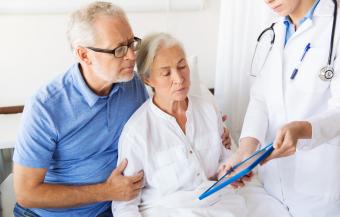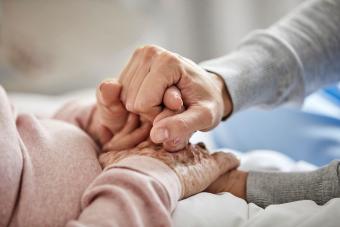
Everyone gets shaky hands from time to time, but regular shakiness is more common in older adults. Shaky hands or having other body parts shake can make simple daily tasks more difficult, so it can be important to address both the causes and potential solutions.
People often associate shakiness (tremors) with Parkinson's disease, but there are a number of other causes of tremors in the elderly and many are benign.
Types of Shakiness in Older Adults
Tremors are involuntary muscle movements that can cause shaking in the hands and other body parts. Tremors range in intensity from slight to severe and can be occasional or constant. The most common types of tremor include:
Essential Tremor
Essential tremor is the most common cause of shakiness in the elderly. This type of tremor is benign and the exact cause is unknown, but evidence suggests it may be hereditary. Essential tremor can occur when moving or at rest and may accompany a head tremor and/or a quivering voice.
The intensity of essential tremor varies from person to person. Some older adults have a mild, slightly noticeable shakiness and others may experience shakiness that can make it difficult to do day-to-day tasks, such as getting dressed or using a computer. Some research suggests that essential tremor is associated with mild cognitive impairment, though more research is needed in this area.
Essential Tremor Symptoms
According to the Mayo Clinic, common essential tremor signs and symptoms include:
- Begins in the hands
- Can be exacerbated by stress, fatigue, caffeine, low blood sugar levels, sleep deprivation or temperature extremes
- Gradual onset, usually in the hands and affecting one side of the body
- May include shaky motion of the head
- Worsens with movement
Treatment of Essential Tremor
If the essential tremor is mild, it may not require treatment. If the tremor has worsened to the point where it is interfering with a person's daily living activities, then treatment may be considered. Common essential tremor treatments include:
- Biofeedback. A noninvasive technique that involves using machines to measure body processes (e.g., skin thermometer) to help people identify when they are in a state of stress and learn to use relaxation techniques to reduce the tremor.
- Weighting. Small wrist weights may be worn to provide relief from shakiness and improve hand and arm functioning.
- Medications. Prescription medications recommended by your physician may include propranolol (beta-blocker), anti-seizure medications, or Botox injections.
A combination of two or more treatments may be recommended, depending on the severity of the essential tremor.
Parkinsonian Tremor
As the name implies, Parkinsonian tremor is commonly seen in people with Parkinson's disease - an age-related neurodegenerative condition. Not everyone with Parkinson's will develop a tremor, but those that do may experience it in the hands, face, and legs. Parkinsonian tremor often begins mildly in one hand and may spread to both sides of the body as the disease progresses. Intense emotions and stress can worsen the shakiness.
Symptoms of Parkinsonian Tremor
Shaky hands are often the first noticeable symptom of Parkinson's disease. According to the Parkinson's Foundation, common symptoms of Parkinsonian tremor include:
- Occurs when awake and at rest and diminishes when using the shaky body part or during sleep
- Pill-rolling: rolling of the thumb and forefinger together as if rolling a pill around
- Supination and pronation: the palm faces up and down repeatedly
Treatments for Parkinsonian Tremor
Prescription medications are the first-line treatment given to control Parkinsonian tremor. Levodopa is the most common medication prescribed, but other drugs (e.g., anticholinergics) may help reduce tremors that do not respond to levodopa. If medications do not provide relief, surgical interventions, such as deep brain stimulation or focused ultrasound may be considered.
Physiologic Tremor
If you hold your arm out in front of you, you may notice a slight shake in your hand. This is known as a physiologic tremor, which occurs in healthy people of all ages and is barely noticeable to the naked eye. It is not a cause for concern and is thought to be caused by the body's natural processes (e.g., heartbeat, muscle activation). Psychologic tremor does not typically require treatment.
Enhanced Physiologic Tremor
Enhanced physiologic tremor is more noticeable than a typical physiological tremor. It is often temporary and goes away once the underlying cause is addressed and treated. Enhanced physiologic tremor may resolve when the underlying cause is determined and effectively treated. For example, if an elderly person experiences shaky hands due to an overactive thyroid, the shakiness should cease once the person is treated with hyperthyroidism medications.
Cerebellar Tremor
Cerebellar tremor, also known as intentional tremor, is a rhythmic, slow and easily noticeable shaking that occurs at the end of a purposeful movement, such as writing with a pen on paper. It occurs after the cerebellum has been injured or damaged. Usually, shakiness from cerebellum tremor occurs after a stroke or from other health conditions such as multiple sclerosis, alcohol use disorder (alcoholism), or a brain tumor.
There are no treatments specifically designed to manage cerebellar tremor, but it may be treated with prescription medications "off-label," such as propanol (beta-blocker), clonazepam (anti-anxiety-medication) or amantadine (commonly used to treat Parkinson's disease). Treating the underlying cause (e.g., multiple sclerosis) may also help reduce shakiness from a cerebellar tumor.
Psychogenic Tremor
Psychogenic tremor, or functional tremor, is involuntary muscle movement caused by an underlying psychological condition. These tremors may start abruptly and cause sudden shaking in the elderly and are often worse when the person is under stress. According to the National Institute of Neurological Disorders and Strokes, many older adults with psychogenic tremor have an underlying mental health condition, such as post-traumatic stress disorder (PTSD) or depression.
Cognitive-behavioral therapy (CBT) has been shown to effectively treat psychogenic tremor. This type of therapy is designed to help people affected learn how to effectively identify and process their emotions and learn how to manage them in healthy ways.
Orthostatic Tremor
Orthostatic tremor is characterized by rapid shakiness and unsteadiness in the legs when standing. Because this tremor disappears when seated or walking, many people with this type of tremor may want to immediately walk or sit again after standing. The tremor is so fast that it may not be seen with the naked eye but can be felt by touching the affected leg.
Orthostatic tremor may be relieved by prescription drugs. Common medications for orthostatic tremor include clonazepam (Klonopin) or an anti-seizure medication called gabapentin (Neurontin). In some cases, Botox may be effective at reducing symptoms and in cases where the tremor is disruptive to the patient's quality of life, surgical treatment such as spinal cord stimulation may be recommended.
Causes of Shakiness in Older Adults
A wide range of medical conditions, prescription drugs and other products people consume can lead to shakiness in older people. In many cases, shaky hands are due to a benign, temporary condition that can easily be corrected. Other times, shaky hands in the elderly may be a sign of an underlying health condition that requires treatment.
According to the National Library of Medicine, the most common causes of tremor and shaky hands in old age include:
- Alcohol misuse or withdrawal. Alcohol-induced hand tremors may occur after excessive alcohol consumption or when a person with alcohol use disorder stops drinking (alcohol withdrawal). Shakiness and tremors can begin as early as 10 hours after the last drink of alcohol and may last for weeks.
- Anxiety and/or stress. When dealing with anxiety or chronic stress, the body is flooded with stress hormones and is in "fight or flight" mode. In some cases, this may lead to twitching or shaking muscles in the hands.
- Excessive caffeine intake. Drinking too many caffeinated beverages can lead to tremor along with other symptoms, such as anxiety and irritability.
- Fatigue. Sleep deprivation can impair a number of body processes and functions and affect the body's muscle and nervous system, leading to shaky hands.
- Huntington's disease. A progressive brain disorder caused by a gene defect. The primary sign of Huntington's is uncontrolled movement of the body (e.g., arms, legs, hands, feet).
- Hypoglycemia. The body relies on glucose (blood sugar) to function properly. If blood sugar levels are too low, shaky hands and other symptoms, such as sweating or hunger, may occur.
- Multiple sclerosis. MS tremors are caused by damage to the cerebellum and surrounding nerves - an area of the brain responsible for controlling balance and coordination.
- Overactive thyroid. Hyperthyroidism occurs when the thyroid gland produces too much thyroid hormone. Twitching and shaking are common symptoms of an overactive thyroid.
- Parkinson's disease. A neurodegenerative disease that most commonly occurs in people ages 60 and older. Degeneration of nerve cells in the brain may lead to shakiness and loss of muscle control.
- Prescription drug side effects. Certain prescription medications may result in shakiness (drug-induced tremor) as a side effect, including corticosteroids, antivirals, mood stabilizers, stimulants, asthma medications, anti-seizure medications, antidepressants and antibiotics.
- Stroke. If a stroke affects the brain's cerebellum, it may result in a tremor that affects the hands during or after the stroke.
When to See Your Healthcare Provider for Shakiness
Contact your healthcare provider if you have shaky hands (tremor) that have developed suddenly, or if the shakiness has persisted for some time. Other reasons to contact your healthcare provider for a tremor include:
- Began after starting a certain medication
- Gets worse at rest and improves with movement (e.g., reaching for an item from the kitchen shelf)
- Is severe and interferes with your daily living activities
- Occurs with other symptoms, including headache, abnormal tongue movements, weakness, dizziness or other involuntary muscle movements
Your healthcare provider will perform ask about your symptoms and perform a physical examination to determine the cause of your shakiness and will recommend an appropriate treatment regimen, depending on the cause.







